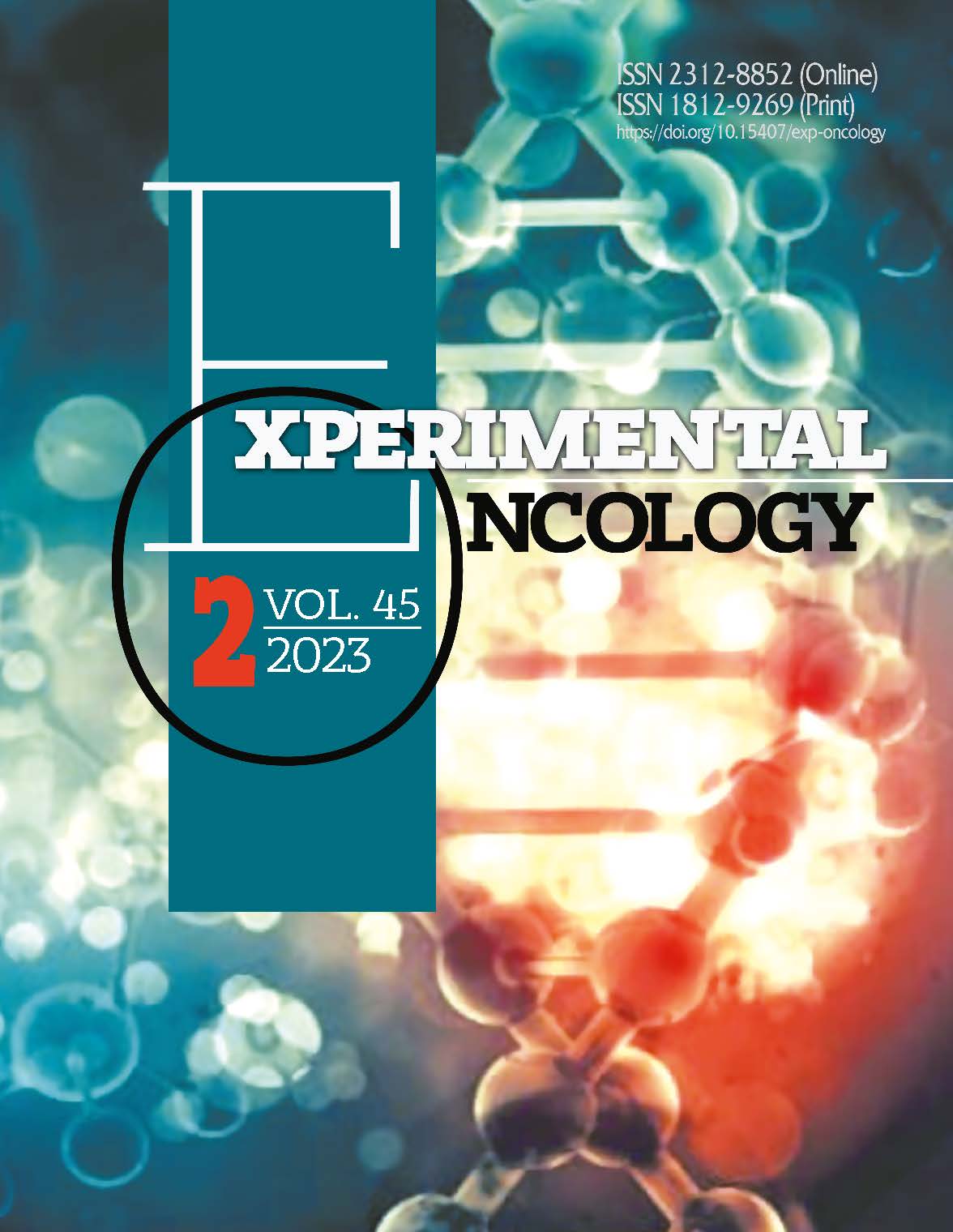ASSOCIATION OF miRNA EXPRESSION PATTERN WITH OUTCOME OF LETROZOLE THERAPY IN BREAST CANCER PATIENTS
DOI:
https://doi.org/10.15407/exp-oncology.2023.02.180Keywords:
breast cancer, miRNA, letrozole, biomarkerAbstract
Breast cancer (BC) remains the most prevalent tumor and the leading cause of death among women worldwide, despite the advancements in diagnosis and new treatments. A significant challenge in BC treatment is the acquired or de novo resistance of tumors to systemic therapy. To overcome this obstacle, personalized treatment is needed, with a focus on finding biomarkers capable of predicting the response to therapy. MicroRNAs (miRNAs) have emerged as potential markers due to their diverse clinical applications. Aim. To examine the potential prognostic significance of miR-125b-2, -155, -221, and -320a expression in the tumor cells of individuals with hormone-dependent BC before undergoing neoadjuvant hormonal therapy. Materials and Methods. The study is based on a retrospective analysis of the treatment outcome of 56 patients with stage II—III locally disseminated hormone-dependent BC. The real-time quantitative reverse transcription polymerase chain reaction was performed on the biopsy material to assess the expression of miR-125b-2, -155, and -221 before neoadjuvant hormonal therapy with aromatase inhibi- tor letrozole to predict clinical response. Results. Most HER2/neu+ BC patients had low levels of miR-155 and miR-221 expression in tumor biopsy specimens. Tumors that responded well to letrozole exhibited lower levels of miR-125b-2 and miR-221 compared to non-responsive tumors. Conclusions. miR-125b-2, -155, and -221 expres- sion can predict resistance to the letrozole treatment of BC.
References
Majumder A, Singh M, Tyagi SC. Post-menopausal breast cancer: from estrogen to androgen receptor. Oncotar get. 2017;8(60):102739. doi: 10.18632/oncotarget.22156
Vilquin P, Donini CF, Villedieu M. et al. MicroRNA-125b upregulation confers aromatase inhibitor resistance and is a novel marker of poor prognosis in breast cancer. Breast Cancer Res. 2015;17:13. doi:10.1186/s13058-015-0515-1
Howard EW, Yang X. microRNA regulation in estrogen receptor-positive breast cancer and endocrine therapy.
Biol Proc Online. 2018; 20:17. doi: 10.1186/s12575-018-0082-9
Pridko O, Borikun T, Rossylna O, et al. Expression pattern of miR-125b-2,-155,-221, and -320a is associated with response of breast cancer patients to tamoxifen. Exp Oncol. 2022;44(4):295-299. doi: 10.32471/exp-oncolo- gy.2312-8852.vol-44-no-4.19152
Curtaz CJ, Kiesel L, Meybohm P, et al. Anti-hormonal therapy in breast cancer and its effect on the blood-brain barrier. Canc (Basel). 2022;14(20):5132. doi: 10.3390/cancers14205132
Kang Y. Landscape of NcRNAs involved in drug resistance of breast cancer. Clin Transl Oncol. 2023; 25(7):1869- 1892. doi:10.1007/s12094-023-03189-3
Zedain A, Badrway H, Refaat A, et al. Using miR-125b in the prediction of aromatase inhibitors resistance in metastatic breast cancer. J Cancer Tumor Int. 2020;10(3):1-9. doi:10.9734/jcti/2020/v10i330127
Bacci M, Giannoni E, Fearns A, et al. miR-155 drives metabolic reprogramming of ER+ breast cancer cells following long-term estrogen deprivation and predicts clinical response to aromatase inhibitors. Cancer Res. 2016;76(6):1615-1626. doi:10.1158/0008-5472.CAN-15-2038
Howard EW, Yang X. microRNA Regulation in estrogen receptor-positive breast cancer and endocrine therapy.
Biol Proced Online. 2018;20:17. doi: 10.1186/s12575-018-0082-9
Di Martino MT, Arbitrio M, Caracciolo D, et al. miR-221/222 as biomarkers and targets for therapeutic in- tervention on cancer and other diseases: A systematic review. Mol Ther Nucleic Acids. 2022;27:1191-1224. doi. org/10.1016/j.omtn.2022.02.005
Submitted: May 20, 2023
Downloads
Published
How to Cite
Issue
Section
License
Copyright (c) 2023 Experimental Oncology

This work is licensed under a Creative Commons Attribution-NonCommercial 4.0 International License.



